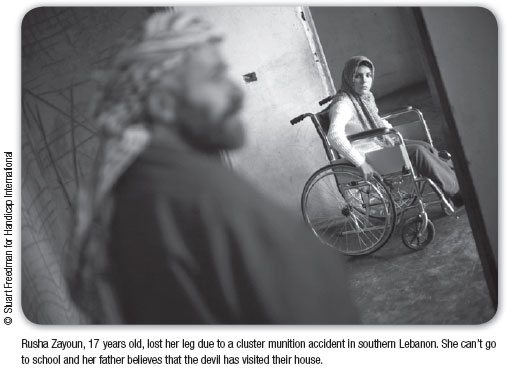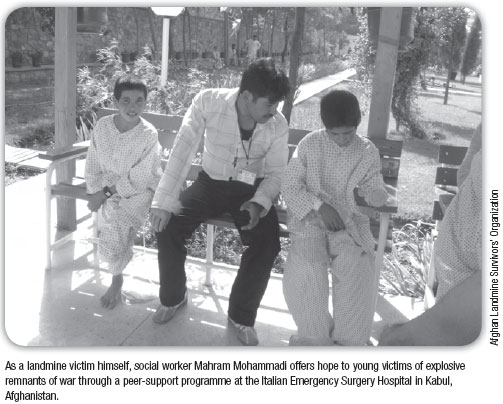NEWS
Banning cluster munitions
On 3 and 4 December, heads of state, foreign ministers and senior government representatives from 94 countries met in Oslo to sign into international law a Convention on Cluster Munitions banning their use, production, transfer and stockpiling. Sarah Cumberland reports.
In 2003, in the immediate aftermath of the invasion of Iraq by coalition forces, Dr Jean-Baptiste Richardier, Director-General, Handicap International, witnessed first-hand what cluster munitions can do to a person. He was taken to one of the main hospitals in Baghdad where more than 300 Iraqi victims of these weapons were lying in the basement. "The victims were being attended to by their families, many helplessly waiting for their likely death," Richardier recalls. When they don't kill immediately, cluster munitions project tiny fragments of metal that penetrate the body everywhere. The misery of the victims is unthinkable, their ultimate death happens under enormous suffering."
And the suffering doesn't stop with cessation of hostilities. Cluster munitions are weapons that scatter smaller bomblets designed to kill or maim on impact. When these submunitions fail to go off, they simply lie on the ground or are buried waiting to be walked on or picked up, sometimes years later.
The likelihood of stumbling across one of these bomblets is far greater in countries such as Afghanistan, the Lao People's Democratic Republic, Lebanon and Serbia where they have been extensively deployed during conflicts. Indeed, in Lebanon, where around four million cluster munitions were dropped during the final few days of the 2006 war, an estimated one million still remained unexploded. To make matters worse, weapons' manufacturers often use attractive colours for their products, a fact lamented by Peter Herby, head of the arms unit, at the International Committee of the Red Cross: "Children often pick them up," he says. "They are attractive and they are dangerous."
Every year thousands of people become victims of mines and so-called explosive remnants of war (ERWs); people like the fisherman in southern Lebanon who pulled up a cluster bomblet in his fishing net. As photojournalist John Rodsted reports: "It blew off both his hands and injured his face so badly that he lost his eyesight"; or Serbian soldier Branislav Kapetanovic, who lost all four limbs when a bomblet exploded as he approached it during a munitions clearing operation. The full extent of the misery caused by landmines and ERWs is difficult to evaluate due to the paucity of data, but according to Katleen Maes, 5426 casualties caused by such devices were reported to Handicap International in 2007, a number Maes thinks probably underestimates the true scale of the problem.
Cluster munitions are particularly pernicious because, as Richardier points out, unlike landmines, they often inflict damage to the eyes and brain. This has serious implications for long-term rehabilitation. "Countries need to establish a chain of rehabilitation that can cope with all these demands. It's much more complicated than just offering prostheses," Richardier says.
And of course, the effects of cluster munitions are not limited to physical trauma. Victims often require years of support to adjust to their new circumstances. "The most important thing is to provide psychological support and rehabilitation while the injuries are being treated," says Kapetanovic. This is a view echoed by Kevin Bryant, who worked for 25 years as a bomb disposal officer for the British Army, and lost a leg clearing mines in Lebanon. "Even though I had accepted the risk as part of my job, I went through a very difficult psychological period," he says. "Five years after the event, I still have down days."
All too often these inevitable psychological problems are exacerbated when victims seek to reintegrate into society. The experience Firoz Alizada in Afghanistan is typical. Having lost both his legs after stepping on a landmine in 1996, Alizada struggled back to health and, determined to do something with his life, applied to study at the university in Kabul. He was rejected because of his disability. He faced similar discrimination when he applied to become a civil servant. He now works for the International Campaign to Ban Landmines (ICBL). For Claude Tardis, head of the Physical Rehabilitation Programme of the International Committee of the Red Cross, the reintegration of people like Alizada into society is one of the key challenges faced by governments. "The main thing that countries need to do is to make sure that victims have access to rehabilitation services, as part of an integrated approach. Even if victims have good physical rehabilitation, they cannot be fully integrated into society if they don't have access to other services such as vocational training," Tardis says.

Those directly affected by cluster munitions are not the only ones to suffer. "Victims are not only those killed or injured," says Wanda Munoz, victim assistance technical adviser with Handicap International. "If the breadwinner of a family is killed or injured, then the whole family suffers." Because most victims need to spend one to five years in hospital, bills mount up, financially devastating individuals and families, but also putting a huge strain on health systems, which are often already fragile.
For the past 18 months, more than 100 countries have been involved in intense negotiations to come up with an international agreement covering cluster munitions and the problems they present. The result is the Convention on Cluster Munitions, the strongest provision to date for victim assistance in international law. The treaty was signed on 3 and 4 December 2008 in Oslo, Norway, by an initial 94 countries. More countries were expected to sign it subsequently. The legally binding treaty will come into force six months after 30 signatory governments have ratified it.
The Convention bans cluster munitions with no exceptions or delays permitted, and calls for the destruction of stockpiles within eight years of signing. For Richardier the treaty comes not a moment too soon. "Given the billions of munitions in stockpile, the treaty will hopefully avert potential massive destruction to people in the future," he says. The Convention also requires the clearing of land contaminated with cluster munitions within 10 years and sets a new standard for assisting victims and protecting their human rights. Signatory states are in fact under the obligation to provide medical, financial and psychological support to survivors and those people affected by cluster munitions.
For Dr David Meddings, in the department of Violence and Injury Prevention and Disability at the World Health Organization (WHO), the fact that the treaty is drawing attention to the health needs of injured people is a significant development. Meddings advocates an integrated approach to post-injury care, whatever the cause, and stresses that, "victims need services from the moment the injury occurs for the rest of their lives. This has fundamental implications for health-systems planning and the priority accorded to trauma and disability services." As things stand that need is far from being met.
Alana Officer, also from the same WHO department, points out that rehabilitation must begin at the earliest possible stage, be as close as possible to individuals' communities, including rural areas, and support their participation and inclusion in society. She indicates that human resources for rehabilitation are a crucial but neglected component of health-system development plans particularly in developing countries. Most primary health care services don't include rehabilitation, while the quality and productivity of the rehabilitation workforce in low-income countries is also lacking. She believes one of the ways forward is to encourage the training of primary health care workers and community and family members in elements of physiotherapy and occupational therapy.


WHO estimates that approximately 30 million people (80% of whom live in developing countries) will be in need of prosthetic devices by the year 2010. This will require around 180 000 health workers with training in provision of these services. At the moment, in developing countries around 400 people qualify each year with the level of training required. More than 75% of developing countries have no training programmes in place for prostheses and orthotics.
The signing of the Convention on Cluster Munitions was timed to coincide with the International Day of Persons with Disabilities. It also happened to be the anniversary of the signing of the 1997 Mine Ban Treaty, an international agreement banning antipersonnel landmines. While covering similar ground, the Mine Ban Treaty fell short of imposing requirements for the provision of victim assistance. Handicap International's Stan Brabant believes that the specificity of the provisions regarding victim support and health care make the newly signed Convention "a very strong tool of enforcement." 
